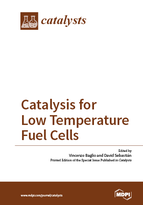Catalysis for Low Temperature Fuel Cells
A special issue of Catalysts (ISSN 2073-4344). This special issue belongs to the section "Electrocatalysis".
Deadline for manuscript submissions: closed (15 January 2017) | Viewed by 85692
Special Issue Editors
Interests: polymer electrolyte fuel cells; direct alcohol fuel cells; water electrolysis; metal–air batteries; dye-sensitized solar cells; photo-electrolysis; carbon dioxide electro-reduction
Special Issues, Collections and Topics in MDPI journals
Interests: energy and environment; catalysis; carbon materials; graphene; carbon nanofibers; electrochemistry; fuel cells; water electrolysis; carbon dioxide electro-reduction
Special Issues, Collections and Topics in MDPI journals
Special Issue Information
Dear Colleagues,
Today, the development of active and stable catalysts still represents a challenge to be overcome in the research field of low temperature fuel cells. Operation at low temperatures demands the utilization of highly active catalysts to reduce the activation energy of the electrochemical reactions involved in the electrodes, and thus obtain practical performances and high efficiencies. At present, the most practical catalysts in low temperature fuel cells are highly dispersed Pt nanoparticles. However, these present several drawbacks, such as high cost, limited earth resources, sensitivity to contaminants, no tolerance to the presence of alcohols and instability due to carbon support corrosion and Pt dissolution. In the search for alternative catalysts, researchers have looked at several strategies: increase of the utilization of Pt catalysts by means of novel structures (metal/support); alloying with transition metals; new carbon and non-carbon supports; cheaper platinum-group-metals like Pd; non-platinum-group metals catalysts (Fe-N-C, Co-N-C, etc.); among others. This Special Issue is intended to cover the most recent progress in advanced electro-catalysts, from the synthesis and characterization to the evaluation of activity and degradation mechanisms, in order to gain insights towards the development of high-performing fuel cells.
Dr. Vincenzo Baglio
Dr. David Sebastián
Guest Editors
Manuscript Submission Information
Manuscripts should be submitted online at www.mdpi.com by registering and logging in to this website. Once you are registered, click here to go to the submission form. Manuscripts can be submitted until the deadline. All submissions that pass pre-check are peer-reviewed. Accepted papers will be published continuously in the journal (as soon as accepted) and will be listed together on the special issue website. Research articles, review articles as well as short communications are invited. For planned papers, a title and short abstract (about 100 words) can be sent to the Editorial Office for announcement on this website.
Submitted manuscripts should not have been published previously, nor be under consideration for publication elsewhere (except conference proceedings papers). All manuscripts are thoroughly refereed through a single-blind peer-review process. A guide for authors and other relevant information for submission of manuscripts is available on the Instructions for Authors page. Catalysts is an international peer-reviewed open access monthly journal published by MDPI.
Please visit the Instructions for Authors page before submitting a manuscript. The Article Processing Charge (APC) for publication in this open access journal is 2700 CHF (Swiss Francs). Submitted papers should be well formatted and use good English. Authors may use MDPI's English editing service prior to publication or during author revisions.
Keywords
- proton/anion exchange membrane fuel cells
- direct alcohol fuel cells
- oxygen electro-reduction
- alcohol electro-oxidation
- electro-oxidation of other organic fuels (formic acid, glycols, etc.)
- hydrogen electro-oxidation
- electrode structure
- catalyst degradation analysis and mechanisms
- pt-group-metal (Pt, Pd, Ir, Rh, Os, Ru) catalysts
- non Pt-group-metal catalysts







